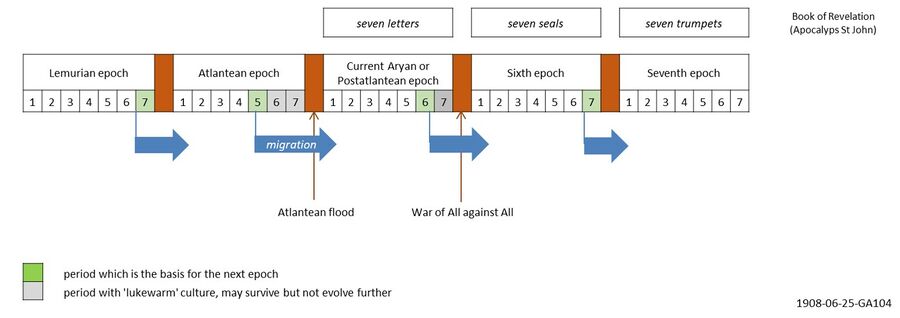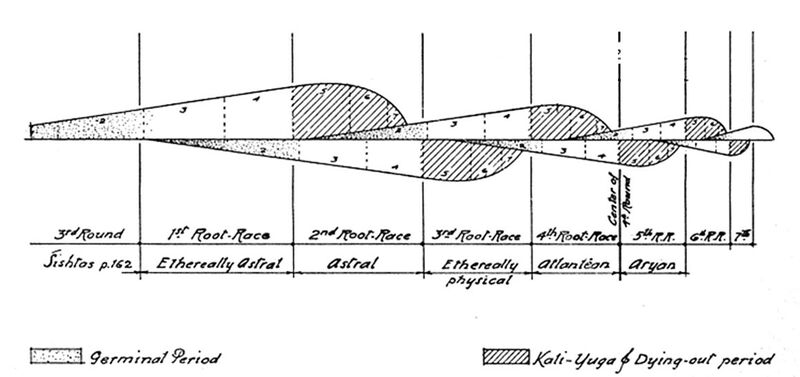Overlapping evolutionary periods
Illustrations
Schema FMC00.169 shows how evolutionary periods should not be seen as discrete and separated periods, but are always overlapping. While an earlier (red) is morphing into the current (green), the future is already developing(blue). This is also related to the symbol of the spiral: evolution does not proceed in linear fashion but takes evolutionary 'jumps'. The spirals show how a wave from the past leads to the seed from which a new wave rises.
The seed used in the plant metaphor (see quote 1907-03-14-GA055 below) corresponds to the cultural age from which the 'sample' for the next evolutionary phase is taken, see Schema FMC00.169A below (quote 1908-06-25-GA104 below). Compare also with FMC00.168 on Recapitulation.
Hence, these schemas give a sense that the future (blue) sixth epoch is already being developed today, in what is developing today for the next sixth cultural age. The fifth and sixth cultural ages are decisive ( see 1910-GA013 quote on the Current Postatlantean epoch.
Schema FMC00.169B is a theosophical illustration of the same principle of overlap.
Lecture coverage and references
1905-05-19-GA092
The fifth root-race arose out of the ancient Semitic races. A trace of this origin still lives in all the sub-races which have so far constituted the fifth root-race. ...
Thus the primal semitic impulse reaches as far as the fifth sub-race. We see the impulses of one great stream penetrate five times into the earliest civilisations.
We have one great spiritual stream coming from the South, which is met by another stream arising in the North, which penetrates into four phases of the early northern civilisation and develops until it meets the first stream, thus flowing together with it.
A childlike, unworldly nation dwelt in northern Europe and these early inhabitants underwent the influence of the stream of culture coming from the South at the turning point of the 12th and 13th century. This new culture penetrated into these regions like a spiritual current of air. Wolfram von Eschenbach was entirely under the influence of this spiritual current.
The northern civilisation is symbolized in the legend of Tannhäuser, which also contains an impulse from the South. Everywhere we come across something which may be designated as a semitic impulse.
There was one thing, however, which was, felt very strongly: namely, that the Germanic races were a last link in this chain of development and that something entirely new would arise, preparing something completely different within the sixth sub-race: the higher mission of Christianity. …
It was felt that the fifth cultural age had to serve still another purpose, that it had to fulfil a special task. The old impulses had ceased, something entirely new was to come, a new spiral curve in the civilisation of the world began. What had come from the South was only an attempt; the kernel was now to be peeled out of its skins. At the turn of the Middle Ages it was felt that something old, which had been experienced as a boon, was setting and had come to an end, and that the longing for something new contained a new impulse which was gradually coming into life.
1907-03-14-GA055 (SWCC)
A widely used sign is the vortex, which can be thought of as two intertwined figure 6's. This symbol indicates and characterizes a certain type of event that can occur both physically and spiritually. For example, a developing plant will finally produce seeds from which new plants similar to the old one can develop. To think that anything material passes from the old plant to the new is materialistic prejudice without foundation and will eventually be refuted. What passes over to the new plant is formative forces. As far as matter is concerned, the old plant dies completely; materially its offspring is a completely new creation. This dying and new coming-into-being of the plant is indicated by drawing two intertwining spirals, that is, a vortex, but drawing it so that the two spirals do not touch.
Many events take place, both physical and spiritual, that correspond to such a vortex. For example, we know from spiritual research that the transition from the ancient Atlantean culture to the first Postatlantean culture was such a vortex.
Natural science only knows the most elementary aspects of this event. ... The spiritual aspect of that ancient culture vanished, and a new culture arose. The vortex is a sign for this event; the inward-turning spiral signifies the old civilization and the outward-turning the new.
As the transition took place from the old culture to the new, the sun rose in spring in the constellation of Cancer — as you know the sun moves forward in the course of the year. Later it rose in early spring in the constellation of Gemini, then in that of Taurus and later still in that of Aries. ... the transition from the Atlantean to the Postatlantean epoch took place under the constellation of Cancer, whose sign is the intertwining spirals — a sign you find depicted in calendars.
The last Lemurian race founded the Atlantean races.
The fifth of the Atlantean races founded our civilizations, of which the sixth will found the future civilization after the great War of All against All. …
The sixth stage (cultural age) will be the foundation for the new civilizations which will arise after the great War of All against All (the sixth epoch); just as our civilization arose after the Atlantean epoch.
On the other hand, the seventh cultural age will be characterized by the lukewarm. This seventh age will continue into the new (sixth) epoch, just as the sixth and seventh races of the Atlantean epoch continued into our epoch as races hardened and stiffening. ...
It was in the fifth stage when the Atlantean emigration began; so that the specially chosen population of Atlantis which lies at the foundation of our culture is taken from the fifth Atlantean race, for in Atlantis we may speak of races.
A sixth and a seventh followed. These were, so to speak the lukewarm races. They also survived the great flood but there was no living sprouting force in them. The sixth and seventh races of Atlantis allowed themselves to become hardened and therefore became stationary. You may still see stragglers of these old overripe races to-day, especially among the Chinese.
Discussion
From Schema FMC00.169 and variants one can understand the reason why in various contexts, the evolution of humanity is counted in cultural ages or sub-races counting only the ones that take part in progressive evolution. See for example Holy Sypper symbolism - apostles.



